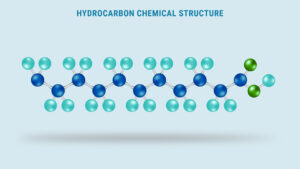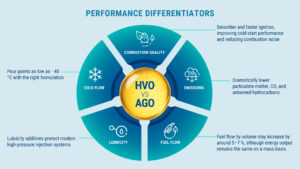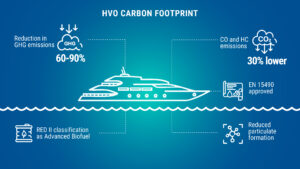
Marine vessels, and yachts in particular, have long relied on diesel-based fuels such as Automotive Gasoil (AGO) or Marine Gasoil (MGO). These fuels are prized for their availability, reliability, and energy density. But as the maritime industry moves towards low-emission fuels and renewable energy solutions, Hydrotreated Vegetable Oil (HVO) — sometimes known as renewable diesel or green diesel — has entered the spotlight.
A common question in technical circles is whether AGO and HVO are truly different fuels, or whether, at a chemical level, they are essentially the same. In this article, we explore the chemical makeup of both AGO and HVO, their molecular similarities, and what this means for marine performance, sustainability, and fuel handling.
Chemical Composition and Structure of AGO
Automotive Gasoil (AGO), often used interchangeably with Marine Gasoil (MGO), is a petroleum-derived distillate fuel. It typically consists of hydrocarbons ranging from C₉ to C₂₁ — mainly paraffins (alkanes), naphthenes (cycloalkanes), and aromatics (benzene-type rings).
AGO is refined through fractional distillation and hydrodesulphurisation, producing a low-sulphur, high-energy fuel that meets ISO 8217 DMA and EN590 standards. Typical characteristics include:
- Density: 820–860 kg/m³ at 15 °C
- Sulphur content: < 10 ppm
- Cetane index: ≥ 46 (often 51 or higher)
- Aromatics: typically < 8 % by volume
This combination of saturated and aromatic hydrocarbons gives AGO its balance of ignition quality, lubricity, and stability. Aromatics help lubricate injection systems but contribute to soot and emissions. The paraffinic fraction — straight and branched alkanes — governs clean combustion and high energy output.
In short, AGO is a complex hydrocarbon blend, predominantly paraffinic, but with enough cyclic and aromatic content to distinguish it from fully synthetic diesel.
Production and Chemistry of HVO
Hydrotreated Vegetable Oil (HVO) is a second-generation biofuel produced by refining natural oils and fats — such as used cooking oil, tallow, or vegetable oils — through hydrotreating.
In the hydrodeoxygenation process, hydrogen removes oxygen from the triglycerides in the feedstock, leaving behind pure hydrocarbons — specifically n-paraffins and iso-paraffins. The result is a fuel made up almost entirely of C₁₀–C₂₀ alkanes with the general formula CₙH₂ₙ₊₂.
Chemically, HVO is indistinguishable from fossil diesel in its core molecular structure. It contains no oxygen, sulphur, or aromatics, and is composed solely of saturated hydrocarbons. HVO typically has:
- Density: 765–800 kg/m³ at 15 °C
- Cetane number: 70–90
- Aromatics: 0–1 %
- Sulphur: negligible (< 1 ppm)
Because it is fully paraffinic, HVO burns exceptionally cleanly, with low soot and smoke, and offers excellent ignition quality.
Molecular Comparison: AGO vs HVO
At the most fundamental chemical level, AGO and HVO are the same kind of hydrocarbon fuel — both are mixtures of paraffinic hydrocarbons within a similar carbon-number range. The key difference lies in purity and origin:
| Property | Automotive Gasoil (AGO) | Hydrotreated Vegetable Oil (HVO) |
| Origin | Petroleum distillate | Renewable (hydrotreated bio-oils) |
| Main composition | Alkanes, cycloalkanes, aromatics | Alkanes (n- and iso-paraffins only) |
| Aromatics content | 3–8 % typical | 0–1 % |
| Sulphur content | < 10 ppm | < 1 ppm |
| Cetane number | ~45–55 | 70–90 |
| Density (15 °C) | 820–860 kg/m³ | 765–800 kg/m³ |
| Energy content (MJ/kg) | ~43 | ~44 |
Both fuels are therefore chemically paraffinic, hydrogen-rich, and free of oxygenated compounds. The absence of aromatics and heteroatoms in HVO makes it slightly cleaner and more stable, with marginally higher cetane and lower density. But in essence, both fuels share the same hydrocarbon framework and are chemically identical in combustion behaviour.
Performance in Marine Engines and Fuel Systems
Because AGO and HVO share almost identical hydrocarbon structures, engine performance is virtually identical when switching between them. Both deliver equivalent power output, combustion efficiency, and engine responsiveness.
However, several subtle differences are worth noting:
- Combustion quality: HVO’s higher cetane number allows smoother and faster ignition, improving cold-start performance and reducing combustion noise.
- Emissions: The absence of aromatics in HVO leads to dramatically lower particulate matter, CO, and unburned hydrocarbons. Sulphur oxides (SOₓ) are effectively zero.
- Fuel flow: Because HVO is less dense, fuel flow by volume may increase by around 5–7 %, although energy output remains the same on a mass basis.
- Lubricity: Both AGO and HVO require lubricity additives to protect modern high-pressure injection systems, as hydrotreating removes naturally lubricating compounds.
- Cold flow: HVO’s iso-paraffinic content gives excellent cold-weather performance — pour points as low as –40 °C are possible with the right formulation.
In marine and yacht engines, HVO can be used as a drop-in replacement for AGO, requiring no hardware or calibration changes. Many OEMs and classification societies now certify their engines for 100 % HVO or HVO blends (e.g. B30, B50, or B100).
Environmental and Sustainability Considerations
While AGO and HVO may be chemically similar, their carbon footprints are very different. AGO is derived from fossil crude oil, whereas HVO originates from renewable or waste-based oils.
When produced from waste feedstocks, HVO can reduce lifecycle greenhouse gas emissions by 60–90 % compared with fossil diesel. It is classified as an advanced biofuel under EU Renewable Energy Directive II (RED II) and meets EN 15940 as a synthetic paraffinic diesel.
In combustion, HVO delivers:
- Zero sulphur and negligible soot
- Up to 30 % lower CO and HC emissions
- A smoother, cleaner exhaust with less odour
- Reduced particulate formation, improving after-treatment performance
For yachts operating in Emission Control Areas (ECAs) or sensitive coastal zones, switching to HVO offers immediate air-quality benefits while maintaining performance parity with AGO.
Compatibility and Use in Yacht Operations
From a practical standpoint, HVO behaves identically to AGO in bunkering, storage, and onboard systems. It meets the same viscosity and flash-point specifications as marine gasoil and can be blended in any ratio.
When switching from AGO to pure HVO, operators should:
- Monitor fuel filters initially, as HVO can dissolve deposits left by older fuels.
- Ensure fuel hoses and seals are rated for paraffinic fuels (modern materials generally are).
- Check additive packages for lubricity and corrosion protection.
Otherwise, no changes to engines, tanks, or handling procedures are required. HVO can be safely mixed with AGO or bunkered separately, and is fully compliant with existing marine fuel standards.
Conclusion
From a chemical perspective, Automotive Gasoil (AGO) and Hydrotreated Vegetable Oil (HVO) are functionally identical fuels. Both are composed primarily of paraffinic hydrocarbons in the same molecular weight range, and both deliver the same energy, performance, and handling characteristics in marine applications.
The distinction lies not in their chemistry, but in their origin and environmental impact. AGO is fossil-based, while HVO is renewable, sustainable, and cleaner-burning — offering a straightforward route to decarbonise yachting and comply with global emissions regulations.
For yacht owners and operators, this means that transitioning to HVO offers all the familiarity and performance of AGO, with the environmental benefits of a next-generation synthetic marine fuel.




